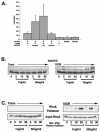Human cytomegalovirus-encoded G protein-coupled receptor US28 mediates smooth muscle cell migration through Galpha12
- PMID: 15254210
- PMCID: PMC446127
- DOI: 10.1128/JVI.78.15.8382-8391.2004
Human cytomegalovirus-encoded G protein-coupled receptor US28 mediates smooth muscle cell migration through Galpha12
Abstract
Coupling of G proteins to ligand-engaged chemokine receptors is the paramount event in G-protein-coupled receptor signal transduction. Previously, we have demonstrated that the human cytomegalovirus-encoded chemokine receptor US28 mediates human vascular smooth muscle cell (SMC) migration in response to either RANTES or monocyte chemoattractant protein 1. In this report, we identify the G proteins that couple with US28 to promote vascular SMC migration and identify other signaling molecules that play critical roles in this process. US28-mediated cellular migration was enhanced with the expression of the G-protein subunits Galpha12 and Galpha13, suggesting that US28 may functionally couple to these G proteins. In correlation with this observation, US28 was able to activate RhoA, a downstream effector of Galpha12 and Galpha13 in cell types with these G proteins but not in those without them and activation of RhoA was dependent on US28 stimulation with RANTES. In addition, inactivation of RhoA or the RhoA-associated kinase p160ROCK with a dominant-negative mutant of RhoA or the small molecule inhibitor Y27632, respectively, abrogated US28-induced SMC migration. The data presented here suggest that US28 functionally signals through Galpha12 family G proteins and RhoA in a ligand-dependent manner and these signaling molecules are important for the ability of US28 to induce cellular migration.
Figures







Similar articles
-
Gα13 mediates human cytomegalovirus-encoded chemokine receptor US28-induced cell death in melanoma.Int J Cancer. 2015 Sep 15;137(6):1503-8. doi: 10.1002/ijc.29506. Epub 2015 Mar 16. Int J Cancer. 2015. PMID: 25754407 Free PMC article.
-
Mouse cytomegalovirus M33 is necessary and sufficient in virus-induced vascular smooth muscle cell migration.J Virol. 2005 Aug;79(16):10788-95. doi: 10.1128/JVI.79.16.10788-10795.2005. J Virol. 2005. PMID: 16051870 Free PMC article.
-
Differential ligand binding to a human cytomegalovirus chemokine receptor determines cell type-specific motility.PLoS Pathog. 2009 Feb;5(2):e1000304. doi: 10.1371/journal.ppat.1000304. Epub 2009 Feb 20. PLoS Pathog. 2009. PMID: 19229316 Free PMC article.
-
The HCMV chemokine receptor US28 is a potential target in vascular disease.Curr Drug Targets Infect Disord. 2001 Aug;1(2):151-8. doi: 10.2174/1568005014606080. Curr Drug Targets Infect Disord. 2001. PMID: 12455411 Review.
-
US28 actions in HCMV infection: lessons from a versatile hijacker.Rev Med Virol. 2005 Jul-Aug;15(4):269-82. doi: 10.1002/rmv.468. Rev Med Virol. 2005. PMID: 15861487 Review.
Cited by
-
The Human Cytomegalovirus, from Oncomodulation to Oncogenesis.Viruses. 2018 Aug 3;10(8):408. doi: 10.3390/v10080408. Viruses. 2018. PMID: 30081496 Free PMC article. Review.
-
Why Are Cytomegalovirus-Encoded G-Protein-Coupled Receptors Essential for Infection but Only Variably Conserved?Pathogens. 2025 Mar 3;14(3):245. doi: 10.3390/pathogens14030245. Pathogens. 2025. PMID: 40137730 Free PMC article. Review.
-
Molecular mechanisms deployed by virally encoded G protein-coupled receptors in human diseases.Annu Rev Pharmacol Toxicol. 2013;53:331-54. doi: 10.1146/annurev-pharmtox-010510-100608. Epub 2012 Oct 22. Annu Rev Pharmacol Toxicol. 2013. PMID: 23092247 Free PMC article. Review.
-
Rat cytomegalovirus gene expression in cardiac allograft recipients is tissue specific and does not parallel the profiles detected in vitro.J Virol. 2007 Apr;81(8):3816-26. doi: 10.1128/JVI.02425-06. Epub 2007 Jan 24. J Virol. 2007. PMID: 17251289 Free PMC article.
-
The Viral G-Protein-Coupled Receptor Homologs M33 and US28 Promote Cardiac Dysfunction during Murine Cytomegalovirus Infection.Viruses. 2023 Mar 9;15(3):711. doi: 10.3390/v15030711. Viruses. 2023. PMID: 36992420 Free PMC article.
References
-
- Amano, M., Y. Fukata, and K. Kaibuchi. 2000. Regulation and functions of Rho-associated kinase. Exp. Cell Res. 261:44-51. - PubMed
-
- Arai, H., and I. F. Charo. 1996. Differential regulation of G-protein-mediated signaling by chemokine receptors. J. Biol. Chem. 271:21814-21819. - PubMed
-
- Arai, H., C. L. Tsou, and I. F. Charo. 1997. Chemotaxis in a lymphocyte cell line transfected with C-C chemokine receptor 2B: evidence that directed migration is mediated by betagamma dimers released by activation of Galphai-coupled receptors. Proc. Natl. Acad. Sci. USA 94:14495-14499. - PMC - PubMed
-
- Bodaghi, B., T. R. Jones, D. Zipeto, C. Vita, L. Sun, L. Laurent, F. Arenzana-Seisdedos, J. L. Virelizier, and S. Michelson. 1998. Chemokine sequestration by viral chemoreceptors as a novel viral escape strategy: withdrawal of chemokines from the environment of cytomegalovirus-infected cells. J. Exp. Med. 188:855-866. - PMC - PubMed
Publication types
MeSH terms
Substances
Grants and funding
LinkOut - more resources
Full Text Sources
Other Literature Sources
Research Materials

